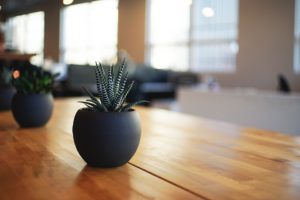
Succulents are a resilient, low-maintenance type of houseplant.
Keeping a houseplant alive seems easy enough: Park it near a window and give it the occasional water shower and it’s good to go. Unfortunately, caring for a houseplant isn’t always that simple. Whether you have little to no experience caring for plants or are a self-professed “black thumb,” getting started with houseplants can be a little daunting. Novice planters should practice with tough, low-maintenance plants and learn the ins and outs of plant care before moving on to the more demanding species.
Best Houseplants for Beginners
- Snake Plants: With their stiff, upright leaves, snake plants are highly resilient and can survive weeks without water and sunlight.
- Spider Plants: Spider plants contain leaves that resemble narrow blades of grass and are one of the most popular types of houseplants due to their ease of growing and minimal required maintenance.
- Devil’s Ivy: Devil’s ivy contains beautiful green and yellow leaves and is known to grow aggressively from pots or trailing baskets.
- Aloe Plants: Known for their medicinal properties, aloe plants contain thick, variegated leaves that require little water.
Care of Houseplants
While not all houseplants require the same amount of maintenance, all require some level of care to thrive. Start by checking the plant’s label for light requirements. While some plants like to bake in the sun all day, others prefer partial sun or shade. If the label recommends direct light, place the plant in a sunny window facing south or southwest. If the label calls for partial or indirect light, place the houseplant in a bright room away from windows or near an east-facing window. If the label suggests low light conditions, place the houseplant in a dark room or in a north-facing window.
Houseplants also require the right size pot. If the container is too large, the moist soil can cause the roots to rot; if it’s too small, the roots can become crowded and starve. As your houseplant grows, it is best to repot it in an appropriate-size container. The pot you choose should have holes in the bottom for drainage, and the soil needs to be nutrient-rich and well-draining. Garden soil is often too heavy for the average houseplant. Instead, opt for a packaged potting mix. During the growing season, provide your houseplant with extra food in the form of fertilizer.
Troubleshooting
- Root Rot: If your houseplant is discolored, worn, or wilted, root rot may be to blame. Root rot is often caused by inadequate drainage and can often be remedied by trimming away the affected roots and pruning a few leaves to promote new root growth. Repot the plant with fresh soil in a container that offers better drainage.
- Disease: Houseplants can succumb to a variety of diseases that often cause slow growth, yellow leaves, and white, powdery blotches. Some diseases, like leaf spot, are associated with poor air circulation and overly warm temperatures. When caring for diseased plants, do not overwater or underwater them, and avoid crowding the plant.
- Plant Pests: Be on the lookout for attacks from pests. Infestations can develop quickly causing damage to soil and foliage. Control invaders with a natural, multipurpose pest control spray like neem oil, which is safe to use indoors.
